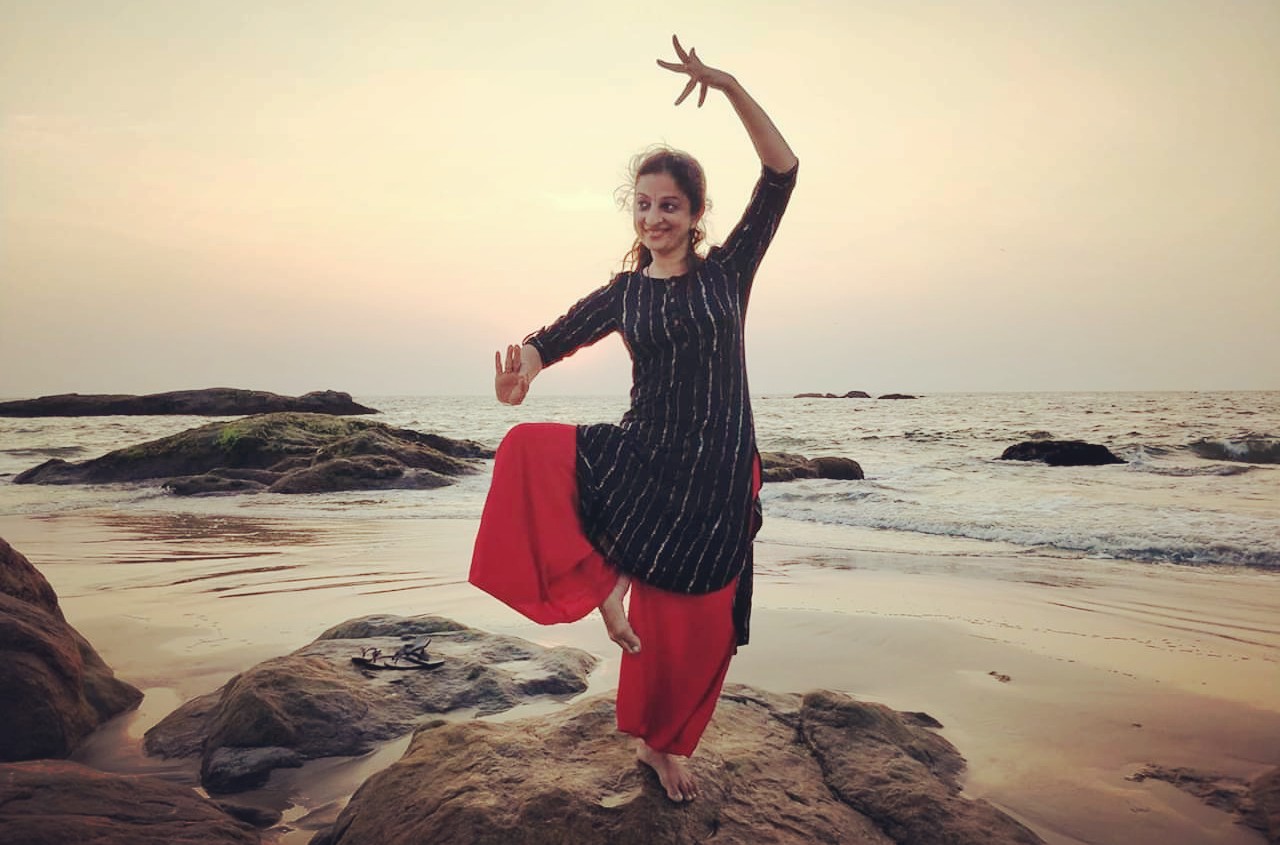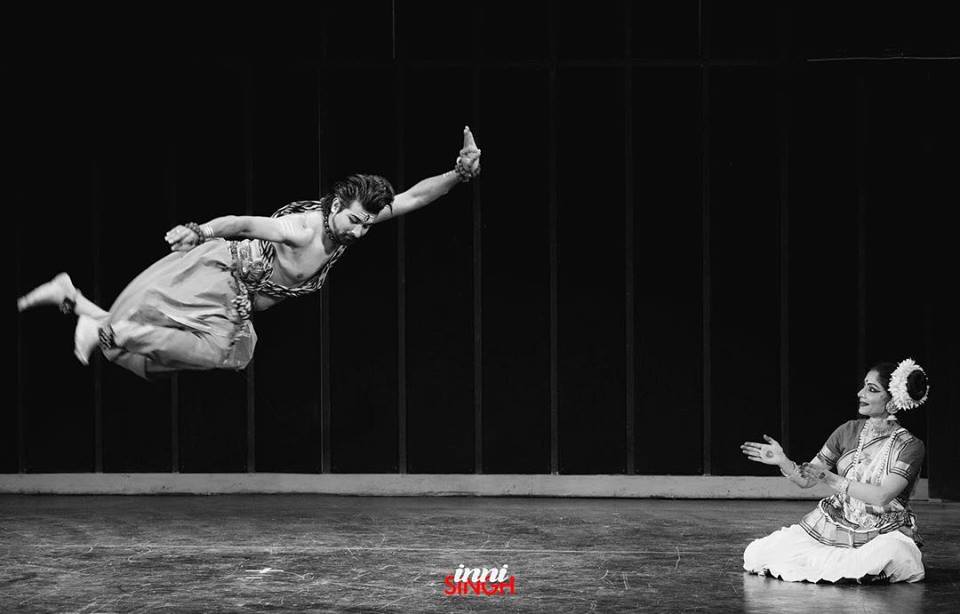Recipient of Bismillah Khan Yuva Puraskar of Sangeet Natak Akademi for the year 2018, Madhulita Mohapatra, a disciple of Guru Gangadhar Pradhan and Aruna Mohanty came to Bangalore some twelve years ago. She was studying at Guru Gangadhar Pradhan’s Odissi Dance Centre in Bhubaneswar. She established Nrityantara Institute of Odissi to train young dancers in Bangalore. The Odiya community settled in Bangalore lent her support and within a year she enrolled some twenty disciples to present them in her very first annual celebration, inviting Guru Gangadhar Pradhan from Bhubaneswar to inaugurate the festival. Performing herself along with her young dancers she generated enthusiasm and also won the goodwill of the local dancers.
The senior local dancers of different genres mainly Bharatanatyam, Kathak and Kuchipudi welcomed her. With their blessings and inviting Aruna Mohanty to conduct Odissi workshops, she laid a strong foundation of Odissi in Bangalore.
Besides Madhulita, Guru Kelucharan Mohapatra’s disciple Sharmila Mukherjee had already established her Sanjali Dance centre to spread Odissi in Bangalore. She also received support from the Bengali community and had generated enough interest amongst local Kannada habitants to learn Odissi. With complete support from her husband, who is an expert IT engineer Madhulita, with diligence displayed tenacity and reached out to more parents who sent their children to her institution.
She also invited senior Odissi exponents from Bhubaneswar and Delhi to perform for her annual shows showcasing the Odissi form of different banis/gharanas.
I was invited during the fourth edition of Naman Festival to see performances of her disciples and also her recital and that of her guru Aruna Mohanty. I was quite impressed by the standard she had achieved in imparting Odissi to young students. With Aruna Mohanty’s guidance, she had also started choreographing Pallavis, abhinaya for Odiya songs and learning Ashtapadis from Gita Govinda from Aruna Mohanty.
[adrotate group=”9″]
When I attended the Naman Festival, Madhavi Mudgal was invited from Delhi. She conducted workshops also during her visit. The young dancers of Madhulita included besides Odiya girls, South Indian and Kannada girls. I could see that Madhulita taught well and did not lack in industry. She also reached out a large number of local schools, where she taught Odissi. From Bhubaneswar, she invited the musicians and scholars and dance critics among them were critic Shyam Hari Chakra and prominent poet and critic Kedar Mishra who wrote lyrics in Odiya language which Madhulita choreographed. From Bhubaneswar Sanskrit scholar and poet Pandit Nityanand Mishra also assisted her when she planned to choreograph Shaivite themes.
Within five years Madhulita had succeeded in establishing her institution and enlisting a large number of students. Kedar Mishra, Shyam Hari Chakra and attended her annual festivals which were going from strength to strength. She invited the senior local Gurus like Smt Lalita Srivisan, Radha Sridhar in Bharatanatyam, Veena Murthy Vijay and Vyjayanthi Kashi in Kuchipudi, Guru Sri Devi in Mohini Attam, Nandini Mehta and Mohan Kalvakalva and others from Kathak and sought their blessings guidance. Her humility and gentle nature along with her hard work helped her gain a reputation as a serious performer, choreographer and a teacher.
This year was the tenth year of celebrations of her Nrityantar Institution and she was planning for a two day dance festival and one day seminar along with Prof Sahana Das, a senior Odissi exponent, a disciple of Guru Mayadhar Raut and Head of Communication Department at Mount Carmel College. She also invited other critics, besides Kedar Mishra, Shyam Hari Chakra, me, Leela Venkataraman from Delhi, Tapati Chowdurie from Kolkata, Madhavi Puranam, editor of Nartanam quarterly from Hyderabad and dance and music critic Hari Bal, from Cochin.
[adrotate group=”9″]
Madhulita by now had a large number of students totalling to two hundred and twenty. As is her practice she presented her tiny tots, junior students and senior students on the first day on 10th August at ADA Rang Mandira auditorium in presence of parents and invited guests from Bhubaneswar, local dancers and gurus. The proceedings began from 3 pm, but we were to join the even around five pm onwards when the senior students were to present a number of Madhulita’s choreographic works.
Of the fare, she presented the two nine-year-old girls Angeleena Avani, a child prodigy and another Prisha Sinha literally stole the show. Angeleena has been performing from the age of five and is completely involved in dancing and learning. I have been watching her from the year she first appeared and surprised us with her well-coordinated dance movements, be it Mangala Charan or an Odiya abhinaya pada. She is doubtless gifted and is a star pupil of Madhulita.

Prisha along with Angeleena presented charming Odiya traditional pada ‘Radharani sange nache Muralipani’ originally choreographed and brought to light by Guru Pankaj Charan Das. Radha is looking at Krishna dancing, dressed in his beautiful dress, wearing ankle bells which make a pleasant sound, they both sit on the swing, play hori, dance together and are seen happy yugal, couple. Being so young and dancing with involvement one was not able to take eyes off them.
Madhulita’s choreography of Varsha, showers of life, set to music by Guru Bijay Kumar Jena and rhythm composition by Guru Bijay Kumar Barik, performed by a group of dancers was interesting in terms of imageries. The streams of water which looked like a necklace of pearls, that broke when lovers were in love play, and the pearls fell like water drops found a felicitous expression through dancing. The concept of the rainy season, its effect on lovers, animals, birds, dancing peacock, were shown imaginatively.
[adrotate group=”9″]
The solo by young Akshati Roychowdhari, a brilliant Odissi dancer trained at Nrityagram of Pallavi in Mohana raga was captivating. Akshati has dance in her body. Vivacious, alert, admirable command over tala and graceful execution of movements with the stamp of Nrityagram bani set her apart from other dancers. I have seen her progress during the past five years and she has always impressed me as a bright dancer. I came to learn that she has taken up a job at Valley school in Bangalore and has moved away from Nrityagram. One hopes she would maintain what she has acquired during her apprenticeship at Nrityagram with care and conscious efforts.
The Sanskrit poem Shivam Dhimahi, in praise of Lord Shiva with inputs from Pandit Nityanand Mishra was polished over the three years and has gained certain gravitas. The epithets of Lord Shiva, with Ganga flowing from his matted locks, the crescent moon shining on his forehead, the neck blue in colour having swallowed poison, which Parvati begged of him not to and which stopped there colouring the neck, Nilakantha, and his Tandava dance liberating the devotees who pray him have been choreographed well, with dancers standing one behind the other in a row, creating images of a multi-armed god. The rhythm composition was by Dhaneshwar Swain and the music was composed by Sukant Kundu both from Bhubaneswar and were present in the auditorium. I have seen this number earlier with another set of students and found that Madhulita handles the group choreography competently.
Madhulita concentrates on choreographing pallavis, pure dance numbers, with music by her well-known musicians. Working with Guru Bijay Kumar Jena for music and for rhythm with Guru Bijay Kumar Barik, the pallavi set to Malhar raga, performed by her senior students who form a core of her troupe is an example of her maturity and competence to explore the pure dance movements.

The groupings, dancing in a circle, creating alignments in various geometric formations, seem visually interesting. All the seven dancers with equal heights, tall, with a good frame and sound training project a pleasant image. Each one of them has a commendable sense of rhythm and movements. The pallavi gathers momentum and with fast pace musically it succeeds in drawing the attention of the audience in an entertaining manner. Paridhi Joshi, Sonali Mohanty, Sahana Maiyya, Vivekini Das, Meghana Das, Anjali Raj Urs and Bhargavi G did Madhulita proud.
[adrotate group=”9″]
Madhulita’s abhinaya to Gita Govinda Ashtapadi ‘Ramati Yamuna pulina vane’, as taught to her by Aruna Mohanty, set to Pilu raga by Subas Pani and in ekatali, deals with Radha imagining Krishna dallying with other Gopis, drawing design with musk on Gopi’s face and drawing her close while kissing, weaving a plate of her luxurious hair, with his palms which look like flash of lightning, and other similes, was a sheer delight to watch. The mukhajabhinaya, with varying expressions on the face, of joy, exhilaration, excitement, wonder Madhulita was able to project admirably, without exaggeration. Careful nurturing by her mentor Aruna Mohanty has helped Madhulita to dance with maturity.

One more noteworthy choreography was Ishwari, an ode to Devi’s three forms: Maa Manakeshwari, Maa Chamundeshwari and Maa Durgeshwari. Taking movements from popular Chattar Jatra procession, the choreography explores the vibrant and fierce attributes of the Goddess, the one which annihilates demon Mahishasura. Dancing like in a trance the dancers moved with frenzy creating the ferocious form of the goddess. The music was composed by Sukant Kundu and rhythm by Dhaneswar Swain with inputs for mythological stories by Pandit Nityananda Mishra. The young dancers performed with zeal alternating between lasya and vigorous stances.
The well-known story of building the Konarka temple and placing the shikhar by the young son Dhramapada, son of the main architect, is a favourite theme with Odiya audiences. The main architect, father of Dhramapada, who did not know how to complete it, and king Narasimha, threatening the architect and his labour force if not completed, he would chop off their heads is quite a gripping story. The sacrifice by Dharmapada, after placing the shikhar on the top and jumping from there so that the King would not admonish the father for not knowing how to place the shikhar and a little boy Dharmapada could do it, would never know was dramatically enacted. The child Dharmapada played by Angeleena and his close friend by Prisha, as usual, natural to them getting involved in their acting, was quite charming. However, various workers at the temple and Dharmapada’s father and the role by attractive young dancer impersonating King Narasimha at times looked incongruous. But this was a case of giving an opportunity to the dancers, which when an annual show is mounted, the teacher has to face. The lyrics were by Professor Nabakishore Mishra, the music by Satyabrata Katha, the rhythm was by Ajay Kumar Choudhary and Soubhagya Chhotray.
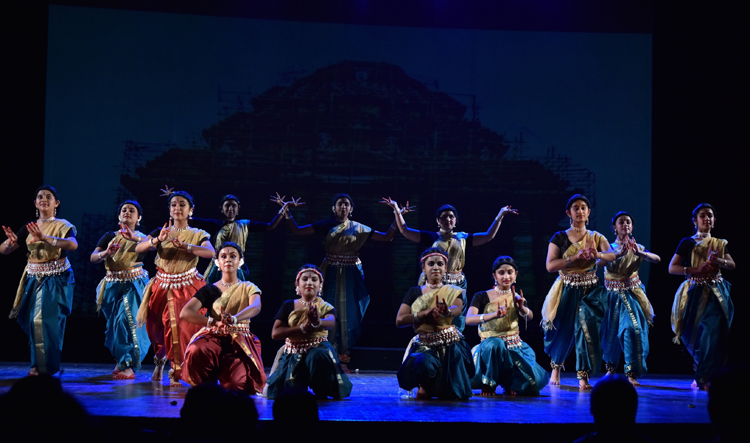
Madhulita had specially invited her first guru under whom she had started studying dance from a village. She also presented Sambalpuri folk dances as a variety for the special 10th edition of Naman Festival.
On the second day, which was to feature Madhulita’s new choreographic work a dance-drama Satyam, Prema Amram ,inspired from the love story of Mirza and Sahiba, the ill-fated lovers, with script and lyrics in Odiya by poet Kedar Mishra, music by Sukant Kundu, the rhythm by Dhaneshwar Swain, featuring Madhulita in the main role of Sahiba as Savini and Mirza as Manhar by Paridhi Joshi, brother of Savini Raivat by Sonaly Mohanty did not meet with the expectations which were raised for handling the tragic tale.
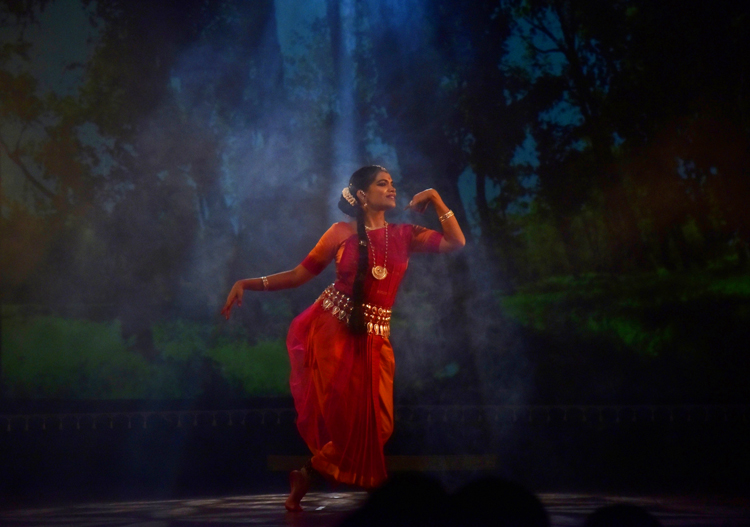
The story did not hold enough emphasis as a tragedy. Despite English commentary and at times Odiya dialogues, things did not jell. Savini’s attempts failed to make her brother realize the futility of war, violence, killing, by breaking all the arrows of Manhar with whom she had eloped, and Raivat, her brother who ran after the couple to punish them and kill Manhar, resulted in Savini killing herself when Manhar dies. The two lovers dying together did not create the expected karuna rasa.
[adrotate group=”9″]
What could have helped Madhulita when she undertook such a production was to have someone as a mentor and a sounding board. Like Nityananda Mishra, Kedar Mishra and a senior choreographer to watch the rehearsals and tighten the loose ends. Of course, in a dance drama dialogues could be used, even in English. It would have been more appropriate to have the synopsis and choreographer’s note circulated earlier by placing the note on each chair and the audience would have read it in advance. Though this often does not help, it is important to train the audience to read the synopsis and avoid long introduction before the dance-drama unfolds. Also, the music when recorded possibly two-three different tracks could be arranged with a view to making changes if necessary.
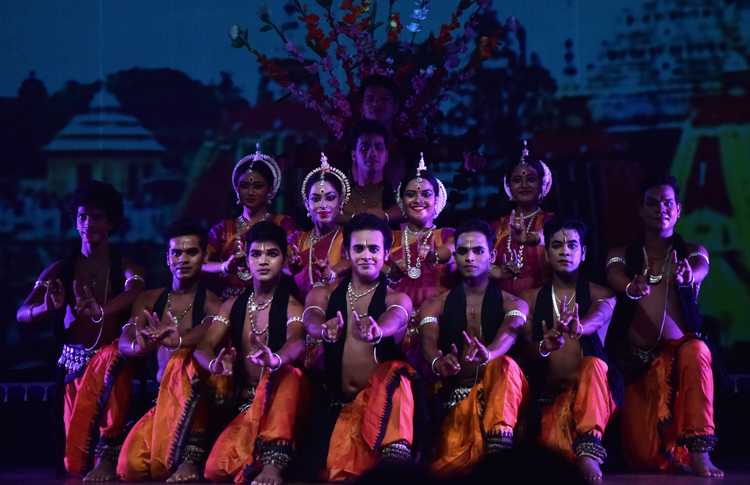
Aruna Mohanty’s Amazing Odissa choreographed for presentation on a large scale for audiences abroad by her Odisha Dance Academy merely of two hours. It was compressed n some sixty and more minutes resulting into rushing through the scenes telling stories of origin of dance traditions, processions, vigorous male dancing, acrobatic Gotipua dancing, which invariably steal the show, and del with Maharis dancing in temples, pallavi performances, enacting mythological story of Mahabharata, Draupadi’s humiliation in view of kings in court, Krishna saving her from disgrace, (linking it with contemporary situation of rape and event of ‘Nirbhaya’), the glory of handicrafts, issue of environment, saving off wild animals, technological progress progress et al,have been woven by Aruna Mohanty with her customary choreographic flair. However, what was distracting was the projection of innumerable visuals, which often distracted from the excellent dancing by the group of Odissi Dance Academy. It would have succeeded a lot of the projection of visuals were selected discretely.
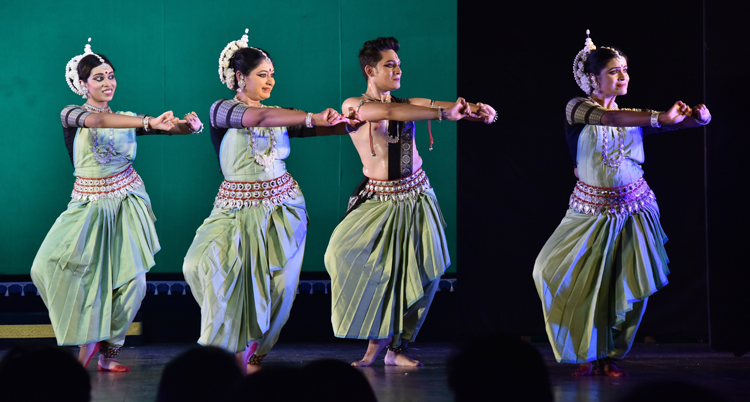
Unfortunately, Sharmila Mkukherjee’s dancers of her Sanjali group, well trained could not salvage her presentation of long Pallavi in Yaman raga in pure dance, to which was dovetailed the story of Ganga, its descend upon earth, the offerings to Ganga as rituals and placing of lamps in water, which had otherwise excellent visuals, with fly whisks, rituals and evocative ambience. What went wrong was the poor quality of the recording and too loud sound. She was to present her much-acclaimed choreographic work ‘Sukshma’, flowering tree but last minute chose to substitute with the work on Ganga. It did not go well with critics and discerning audience. I suggest Sharmila take off this work from her repertoire because it does not do justice to her otherwise excellent works like Suskshma and one based on Swanlake.
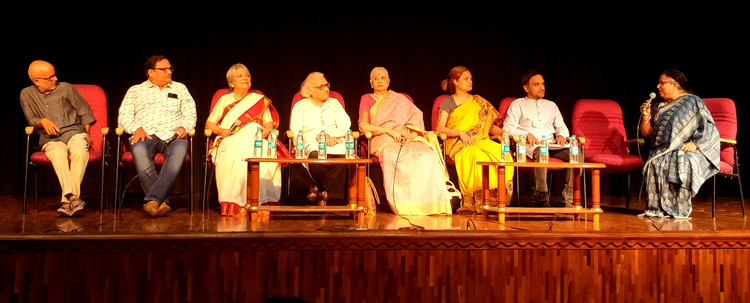
On the third day, on 12th August at Mount Carmen college the seminar on globalization of dance, economics, standards of Odissi dance in present times, need for dance criticism, corporate support, influence of Bollywood dances, presentation of various Odissi dance festivals organized by Shyam Hari Chakra, the need for study of other arts like music, painting, sculpture and economic support, rise of mediocrity and lowering standards and dwindling audiences were discussed. Professor Sahana Das of Communication Dept moderated the discussion very well. Earlier for the students of Communication Dept, the documentary on Mrinalini Sarabhai, scripted, directed, lit up and filmed by Yadavan Chandran and Mallika Sarabhai was screened. The young students had asked many questions and the discussion was provocative. I would like to compliment Prof Sahana Das for taking initiative in collaboration with Nrityantar and Madhulita Mohapatra and for the discussion. Prof Sahana das has been arranging Jugalbandhi bringing dancers of two diverse forms and seeking common elements. The aim to popularize classical dance is a welcome movement.







